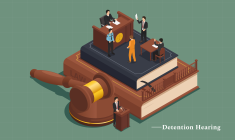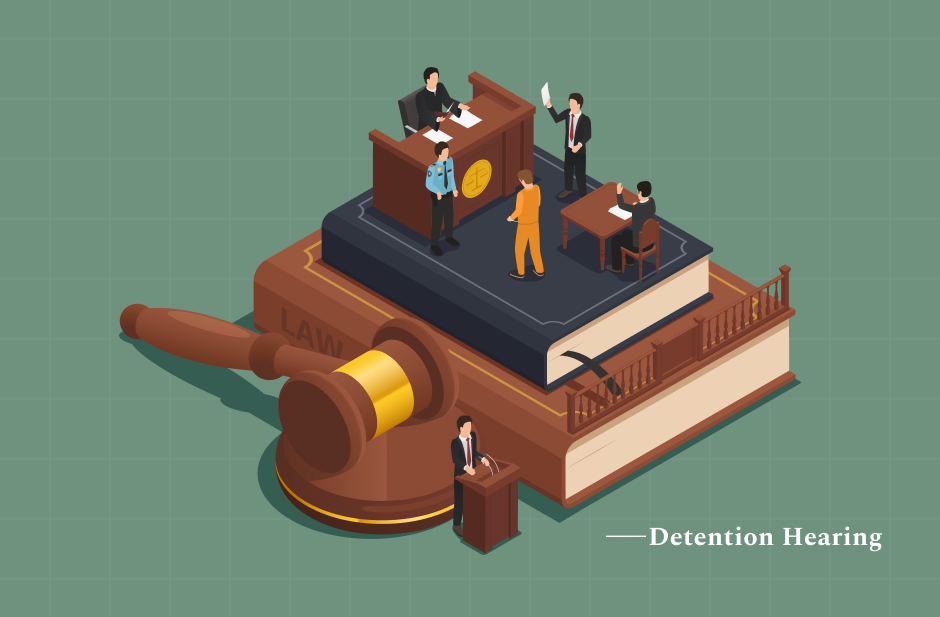The police arrest a close relative of yours; they sit in jail. One of the first and most critical legal events is the detention hearing. That hearing will determine their freedom as the case moves forward.
It’s not a trial about guilt. On the contrary, the judge decides whether a person must stay in custody or if release with conditions is possible.
The detention hearing is a formal judicial process that makes a determination of flight risk, danger to the community, or other issues regarding the person’s detention status. It is an important process to learn about.
What Is A Detention Hearing? What Happens At A Detention Hearing
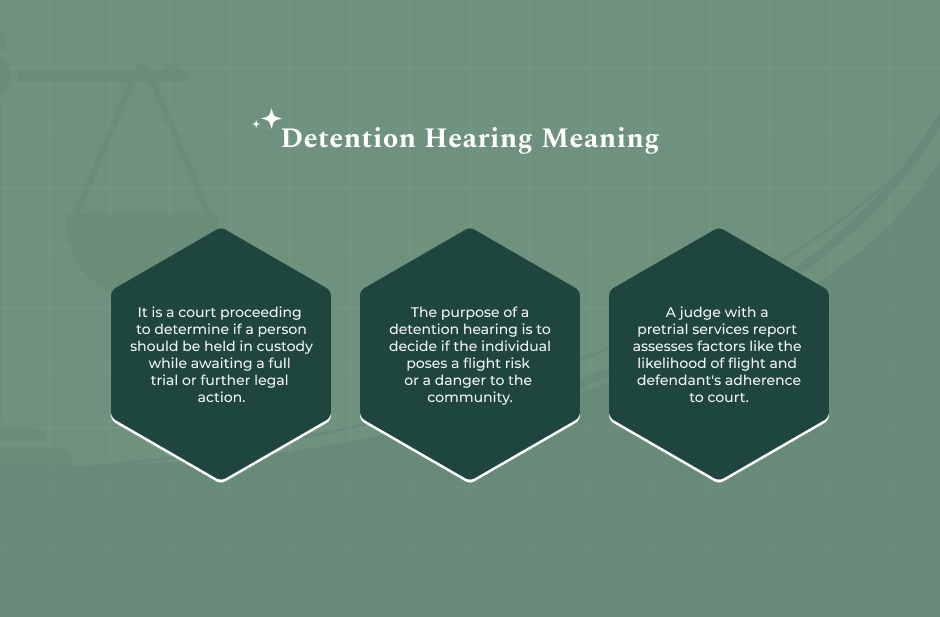
A detention hearing is a legal proceeding that deals with pre-trial detention versus release. The purpose of the hearing is not to determine if the defendant committed the crime, but rather to focus on the risk the defendant presents if they leave custody. This distinction is important.
Detention Hearing Meaning – Bail Vs. Detention
Many people confuse a bail hearing with a detention hearing; they differ. A bail hearing sets a monetary amount for release, while the detention hearing goes further.
The prosecution contends, in particular, that no condition of release, including the nexus of a high bond, could reasonably assure either the defendant’s future appearance or community safety.
If the judge accepts, then the defendant remains detained and cannot get out on bail. Pretrial detention in federal practice is governed by 18 U.S.C. § 3142. Under that statute, the grounds for ordering detention are outlined.
It is an essential stage that ensures the protection of the defendant’s liberty while having in mind the protection of the safety of the public. A detention hearing outcome sets the course for each subsequent stage in a case, as per the 18 U.S.C. § 3142 and U.S. Department of Justice Manual 9-6.100.
When & Why A Detention Hearing Occurs
Now let’s get into details about timings, shall we?
Strict Timing And Deadlines
The law requires a speedy determination of pretrial release, and detention hearings are, accordingly, strictly time-limited.
Federal Cases
Following the initial appearance, which involves reading of charges, a federal detention hearing is set within three days. The court can give extensions, but they are short.
Juvenile Cases
Rules are often even more strict for minors. For instance, many states require that a juvenile detention hearing be held within 24-72 hours of a minor coming into custody. This rapid process demonstrates a child’s best interest, according to the Washoe County Public Defender.
Situations That Trigger The Hearing
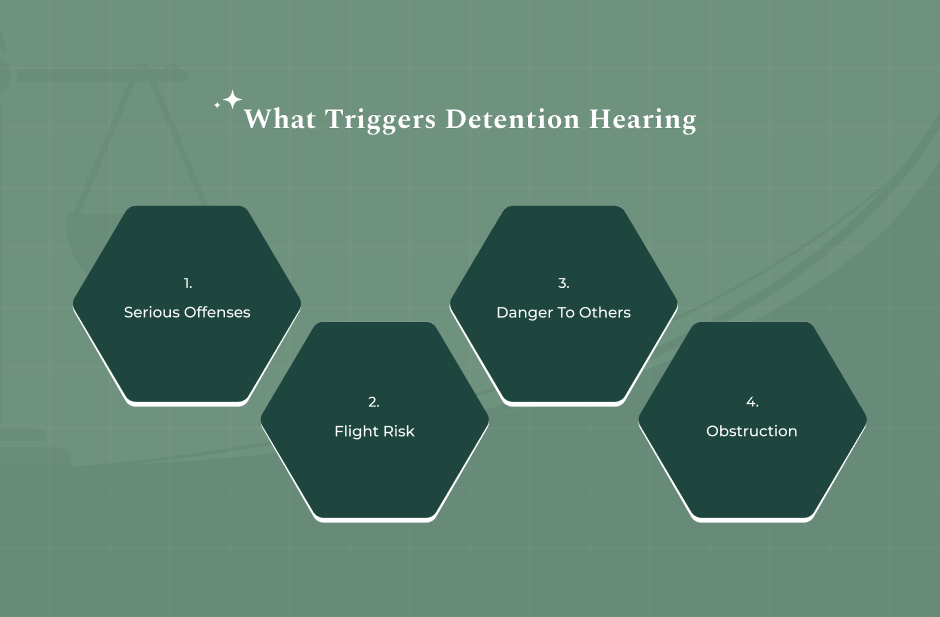
The prosecutors reserve the motion for a detention hearing only for serious cases, including:
Serious Offenses
Offenses that are usually punished with a presumption of detention, like crimes of violence, some drug trafficking offenses, and terrorism, require a defendant to present credible evidence to argue for release.
Flight Risk
The defendant is a flight risk. They will not show up because they have no reason to remain in the community.
Danger To Others
There exists evidence that the defendant poses a serious, imminent threat to a person or the community if released to their home.
Obstruction
The court finds evidence that may indicate the defendant can interfere with witnesses or destroy evidence, as per the Bail Reform Act, 1984.
Key Legal Criteria And Factors
The judge at the detention hearing carefully weighs the evidence presented, balancing the presumption of innocence against the concerns for public safety.
Above all, the judge considers the flight risk and the danger to society. He examines the following factors:
Nature Of The Offense
The gravity of the offense allegedly committed.
Weight Of Evidence
The apparent strength of the government’s case, though this is not a finding of guilt.
Defendant’s History
Prior criminal history is especially relevant when there have been previous failures to appear.
Community Ties
This includes proof of stability. One has to show ties to family, length of residency, employment history, and things like that. These indicate that the defendant will show up in court.
Conditions Of Release
The defense shall propose a concrete plan, which can be electronic monitoring, home confinement, or drug testing. It is upon the court to decide whether these conditions assure safety and appearance.
Finally, the court must conclude that there is no combination of conditions that will reasonably assure such results before ordering detention, according to the U.S. Code
Rights And Protections At The Detention Hearing
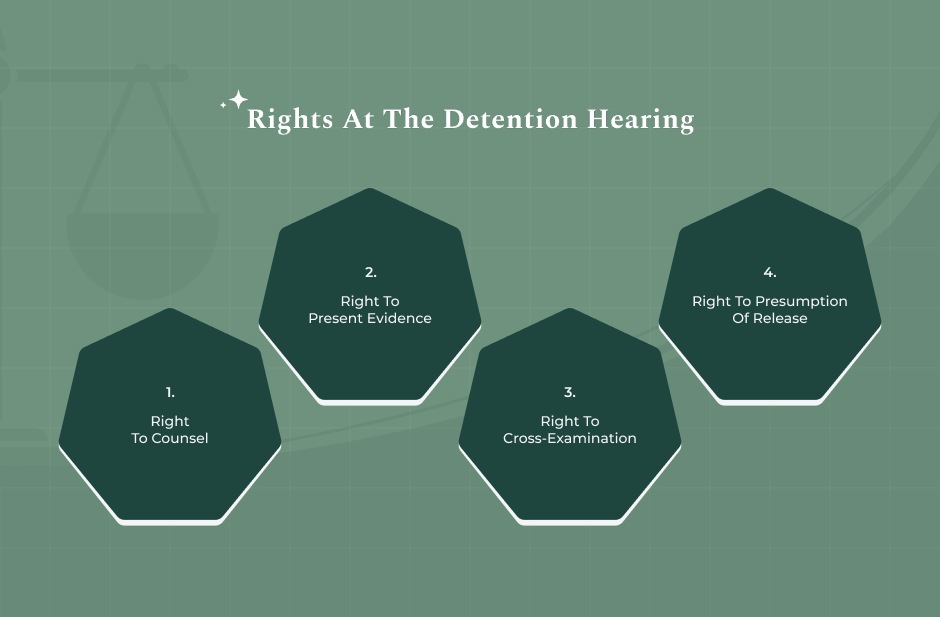
At a detention hearing, there are critical rights for the defendant, even at this early stage.
Right To Counsel
The defendant has a right to an attorney and, if unable to afford one, the court is required to appoint a public defender.
Present Evidence
Where the defendant and his attorney can present testimony, call witnesses, and offer documents in support of release.
Cross-Examination
The defense lawyer can challenge any testimony or object to any evidence brought forward by the prosecutor.
Presumption Of Release
Generally, the law favors release. It is incumbent upon the prosecutor to show that detention is necessary.
The standard of decision is usually “preponderance of the evidence” for flight risk, and “clear and convincing evidence” for danger. Both of these standards are lower than “beyond a reasonable doubt” at trial.
Step-By-Step Procedure
A detention hearing proceeds with a rapid but orderly progression.
1. Pre-Hearing Stage
Thereafter, a motion for detention will be filed by the prosecutor. In most instances, pretrial services will prepare a report regarding the defendant’s background and risk factors.
2. Hearing Stage
Both the prosecutor and the defense attorney make arguments. The prosecutor presses for the issue of risk, while the defense responds by citing community ties and offering conditions of release.
3. Cross-Examination
The defense attorney challenges the police reports or assessment of risk. The defense summons witnesses, such as family members, who would testify about supervision
4. Judge’s Decision
The judge’s decision: The judge shall rule orally or in writing, but must give oral or written findings as a basis for ordering detention or release.
5. Post-Decision
The defense may later move to reconsider if the defendant is detained when there is new evidence.
Juvenile Vs. Adult Detention Hearings
The juvenile process aims at rehabilitation, while the adult system emphasizes protection.
Adult Focus
Public safety and the integrity of the trial are paramount.
Juvenile Focus
Detention is a last resort in the best interest of the child. Criteria involve home environment, maturity, and needs for therapy. Outcomes have supported releasing to parents or placing in a non-secure facility.
Consequences & Societal Impact Of Pretrial Detention
The result of the detention hearing has concrete and lasting consequences. Pre-trial detention is associated with a higher likelihood of guilty plea and longer sentence, holding other variables constant.
People plead guilty simply so that the detention ends and they get “time served.”
Disparities And Detention
The system creates vast disparities: those who cannot afford bail are often the ones detained. According to data, over 60% of the people held in local jails are legally innocent and awaiting trial.
These policies have disparate impacts across different racial groups. Non-Hispanic Black people comprise about 14% of the total general population in the United States. However, they comprise about 39% of the jail population and roughly the same percentage of those held pretrial (Bureau of Justice Statistics).
On the other hand, non-Hispanic Whites compose about 60% of the United States population but make up about 45% of the jail population.
That disparity is a subject of great concern about the pretrial system and initial detention hearing decisions. Detention results in loss of employment, housing, and family stability.
Best Practices And Strategic Advice
Winning the detention hearing is an important strategy.
Present A Plan
This means the attorney must provide a definite and concrete release plan, which in reality means providing the name of a safe and stable residence for the defendant.
Evidence Collection
Letters by employers, family, and community members provide evidence for strong ties to the community.
Challenge Testimony
The attorney must challenge the testimony presented against you. He must indicate some weaknesses in the argument presented about flight risk or danger.
A successful detention hearing requires preparation, expedient motion practice, and aggressive advocacy. The defendant’s liberty hangs in the balance.
Frequently Asked Questions (FAQs):
One of the most important gatekeepers in the entire criminal justice process involves a detention hearing. It weighs the right to liberty for the defendant against public safety.
While it does not happen often, the securing of experienced legal counsel at this early stage is not to be underestimated.
Yes. If the judge orders detention, then your attorney may file a motion to reconsider based upon new facts.
You can similarly appeal the detention hearing order to a higher court if you believe that the judge made a legal error.
No, the judge’s decision at the detention hearing is not final. The defense attorney may ask the court to reopen the hearing on a date after the initial hearing. This happens once the conditions of the defendant have changed, which includes getting stable housing or being admitted into a treatment program.
One of the most fundamental rights came from the Supreme Court Case Gerstein v. Pugh, 1975. It concluded that an individual arrested without a warrant is entitled to a prompt judicial determination of probable cause. This decision solidified the call for timely detention hearing review.

